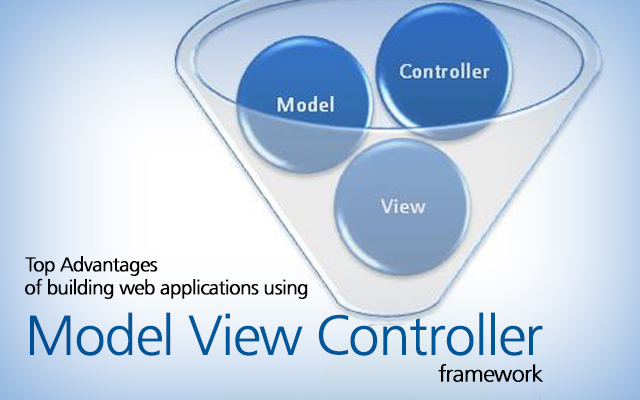Top Advantages of building web applications using MVC framework
MVC stands for Model View Controller - this is a model used for software development purposes. It is popular among various major programming languages today such as Java, PHP, ASP.NET etc. It has a pattern followed by many of the developers for customizing World Wide Web applications at ease. Model holds the business rules, functions and logic. View represents data structure or a chart or a diagram. Controller controls the model and the view.
 Today it is being used as the powerful framework for building web applications using MVC pattern. The Model represents the application core, whereas the View displays the data and the Controller handles the input. The MVC separation helps one to manage complex applications, because one can focus on one aspect at a time. For example, one can focus on the view without depending on the business logic and thus makes it simpler and easier to test a web application. Here both the view and the controller depend on the model; the model depends on neither the view nor the controller. This is one the main advantages of the separation. Hence this allows the model to be built and tested independently of the visual presentation. The separation between the view and the controller is secondary in many client applications and many user interface frameworks implement the roles as one object as one package, thus no interference in each of the module.
Today it is being used as the powerful framework for building web applications using MVC pattern. The Model represents the application core, whereas the View displays the data and the Controller handles the input. The MVC separation helps one to manage complex applications, because one can focus on one aspect at a time. For example, one can focus on the view without depending on the business logic and thus makes it simpler and easier to test a web application. Here both the view and the controller depend on the model; the model depends on neither the view nor the controller. This is one the main advantages of the separation. Hence this allows the model to be built and tested independently of the visual presentation. The separation between the view and the controller is secondary in many client applications and many user interface frameworks implement the roles as one object as one package, thus no interference in each of the module.
In web applications, on the other hand, the separation between view (the browser) and controller (the server-side components handling the HTTP request) is very well defined. The MVC separation also simplifies team development. Different programmers can work on the business logic, view and the controller logic parallel thus without interfering in each other’s work.
Introduction of MVC in ASP.Net
In ASP.Net, there was a need to change the ASP.NET development pattern because working with Webforms became a difficult task, When MVC did come, it is now instrumental in meeting different business demands and making developer work easier. Let us understand what were the main disadvantages of Webforms in ASP.NET.
With each new version, MVC is getting more and more productive and helping develop richer and far more effective solutions.
Top Advantages of building web applications using MVC framework
MVC Framework is built upon a proven MVC design-pattern. ASP.NET has one of the major defects where it uses HTML size of controls and view state. View state stores all the HTML rendered data and the final HTML gets too large. If there is a slow internet connection, the load time is delayed. This has been taken care in MVC framework. MVC framework does not deal with view state concept. With MVC and JQuery integration makes it even better to write code that runs in the browser and takes away load from the server. Thus loading application quickly saving lot of development time. It also supports multiple views and unit testing as a part of Visual Studio 2008 and 2010. The MVC architecture isolates the domain logic from the user interface, allowing for quicker, more controlled development. MVC is under continued enhancements and getting finer day by day, providing more benefits with each new version.
MVC manages complexity because of its separated nature of model-view-controller makes it easier to manage the complexity of large applications and keep it well organized. Programmers are able to focus on one aspect of execution at a time, such as concentrating on the view without depending on the business logic or vice-versa. Some functions and classes of MVC can even be auto-created to save time. With MVC, it is faster test-driven development. Testing applications get easier than it is to test form-based ASP.NET web applications. This is because the separation of application tasks are all defined differently so they add no more complexity. Programmers can test their development work by writing a failing automated test case to define a desired improvement then evaluating the new code.
Because of the flexible coupling of the MVC architecture, rapid and parallel development is possible. It is much easier for more than one developer can code at the same time on the application. If one programmer is working on the view, another can work on the controller logic and the other on the business logic in the model, the application is capable enough to be completed three times faster. With model-view-controller, development gets quicker and independent, thus saving development time. The MVC framework gives full control over the behavior of their application because MVC does not use a view state or server-based forms. Since the controller uses different pieces of the model and view to create a request, many of these parts can be reused in other MVC applications. These reusable building blocks are chosen by the controller to handle specific processing and display needs.
The model-view-controller architecture also integrates with the JavaScript Framework. This means, MVC applications can be made to work with applications outside web pages, such as PDF documents, site-specific browsers, and desktop widgets. It also supports asynchronous calls to such scripts which results to faster loading.
MVC gives the ability to control the application. Rather than using Viewstate or Postback events to store the state of server controls on the page and to manage invocation of server side events, MVC instead uses different view engines to generate the markup that streams back to the browser client. The advantage here is that one can easily produce more standard markup and have greater control over what will be rendered to the client.
As a way to solve developers issues on time, everyone have been turning to MVC frameworks which promise increased productivity and maintainable code. Thus gaining more momentum in business growth.
We provide .net application development services. If you would like to talk to one of our certified .net developers, please get in touch with us at Mindfire Solutions.
 Today it is being used as the powerful framework for building web applications using MVC pattern. The Model represents the application core, whereas the View displays the data and the Controller handles the input. The MVC separation helps one to manage complex applications, because one can focus on one aspect at a time. For example, one can focus on the view without depending on the business logic and thus makes it simpler and easier to test a web application. Here both the view and the controller depend on the model; the model depends on neither the view nor the controller. This is one the main advantages of the separation. Hence this allows the model to be built and tested independently of the visual presentation. The separation between the view and the controller is secondary in many client applications and many user interface frameworks implement the roles as one object as one package, thus no interference in each of the module.
Today it is being used as the powerful framework for building web applications using MVC pattern. The Model represents the application core, whereas the View displays the data and the Controller handles the input. The MVC separation helps one to manage complex applications, because one can focus on one aspect at a time. For example, one can focus on the view without depending on the business logic and thus makes it simpler and easier to test a web application. Here both the view and the controller depend on the model; the model depends on neither the view nor the controller. This is one the main advantages of the separation. Hence this allows the model to be built and tested independently of the visual presentation. The separation between the view and the controller is secondary in many client applications and many user interface frameworks implement the roles as one object as one package, thus no interference in each of the module.In web applications, on the other hand, the separation between view (the browser) and controller (the server-side components handling the HTTP request) is very well defined. The MVC separation also simplifies team development. Different programmers can work on the business logic, view and the controller logic parallel thus without interfering in each other’s work.
Introduction of MVC in ASP.Net
In ASP.Net, there was a need to change the ASP.NET development pattern because working with Webforms became a difficult task, When MVC did come, it is now instrumental in meeting different business demands and making developer work easier. Let us understand what were the main disadvantages of Webforms in ASP.NET.
- Web forms by nature hide all the nature of HTTP.
- The user has no more control on the HTML markup generated by Web forms.
- There is no separation of Concerns in web forms. Presentation and business logic are tightly coupled in web form. For example, ASPX and ASPX.VB (or) ASPX.CS files are tightly coupled or depend one another. The Design (Presentation Logic) and Code Logic cannot be separated.
With each new version, MVC is getting more and more productive and helping develop richer and far more effective solutions.
Top Advantages of building web applications using MVC framework
MVC Framework is built upon a proven MVC design-pattern. ASP.NET has one of the major defects where it uses HTML size of controls and view state. View state stores all the HTML rendered data and the final HTML gets too large. If there is a slow internet connection, the load time is delayed. This has been taken care in MVC framework. MVC framework does not deal with view state concept. With MVC and JQuery integration makes it even better to write code that runs in the browser and takes away load from the server. Thus loading application quickly saving lot of development time. It also supports multiple views and unit testing as a part of Visual Studio 2008 and 2010. The MVC architecture isolates the domain logic from the user interface, allowing for quicker, more controlled development. MVC is under continued enhancements and getting finer day by day, providing more benefits with each new version.
MVC manages complexity because of its separated nature of model-view-controller makes it easier to manage the complexity of large applications and keep it well organized. Programmers are able to focus on one aspect of execution at a time, such as concentrating on the view without depending on the business logic or vice-versa. Some functions and classes of MVC can even be auto-created to save time. With MVC, it is faster test-driven development. Testing applications get easier than it is to test form-based ASP.NET web applications. This is because the separation of application tasks are all defined differently so they add no more complexity. Programmers can test their development work by writing a failing automated test case to define a desired improvement then evaluating the new code.
Because of the flexible coupling of the MVC architecture, rapid and parallel development is possible. It is much easier for more than one developer can code at the same time on the application. If one programmer is working on the view, another can work on the controller logic and the other on the business logic in the model, the application is capable enough to be completed three times faster. With model-view-controller, development gets quicker and independent, thus saving development time. The MVC framework gives full control over the behavior of their application because MVC does not use a view state or server-based forms. Since the controller uses different pieces of the model and view to create a request, many of these parts can be reused in other MVC applications. These reusable building blocks are chosen by the controller to handle specific processing and display needs.
The model-view-controller architecture also integrates with the JavaScript Framework. This means, MVC applications can be made to work with applications outside web pages, such as PDF documents, site-specific browsers, and desktop widgets. It also supports asynchronous calls to such scripts which results to faster loading.
MVC gives the ability to control the application. Rather than using Viewstate or Postback events to store the state of server controls on the page and to manage invocation of server side events, MVC instead uses different view engines to generate the markup that streams back to the browser client. The advantage here is that one can easily produce more standard markup and have greater control over what will be rendered to the client.
As a way to solve developers issues on time, everyone have been turning to MVC frameworks which promise increased productivity and maintainable code. Thus gaining more momentum in business growth.
We provide .net application development services. If you would like to talk to one of our certified .net developers, please get in touch with us at Mindfire Solutions.










Comments